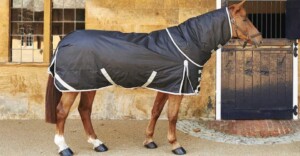Penny Newbold sheds some light on the various theories behind the great rugging debate.
The when, what, how and why of rugging is possibly some of the most heatedly (and yes that pun was well and truly intended) debated topic of equine care today.

There are some rugging theories that have been around for a while yet are often unfounded, and nobody knows quite how they got started.
People often say: But rugging keeps my show horse’s coat from growing. Sorry, but this one is a complete myth! Your horse’s coat growth relates solely to light exposure, so once the light hours start decreasing, the hair starts to thicken in readiness for colder weather. Otherwise, those horses in colder climates would grow thicker, woollier winter coats, while those in the tropics would hardly grow one at all. And we all know that doesn’t happen!
Yes, with rugging, the coat appears less keeping your horse rugged keeps the coat cleaner and an oil, grime free coat does appear thinner. A coat that is constantly rugged is also flatter just from being permanently weighted down the natural mechanism of the coat to fluff (a protection mechanism designed by nature to maintain body temperature) is reduced.
Committed showies who want their ponies to maintain a shorter coat, stable them, keeping the lights on for a few extra hours to ensure the dreaded winter coat stays away.
The alternative is to clip your horse’s winter coat. This adds another dimension to the rugging dilemma. Without their protective coat, they are not only susceptible to skin problems (their skin is now unnaturally
exposed to the elements, even if rugged) requiring extra care (oils, creams, satin lining on their rugs to prevent rubbing etc), they also require constant vigilance to ensure they are adequately clothed to protect them from the weather.
The best rule to follow is to rug enough that they don’t have to use a lot of energy to maintain the correct body temperature. This means not too hot, not too cold. But how do you know?
Monitor your horse and record his reaction in certain weather types. What temperature is it? Is it windy? Light breeze? Raining? Snowy? Is he sweating? Every horse will be a little different, one sweats on a 16 degree sunny day, another will be feeling chilly and have the shivers.
Rugging can be very different for every horse as it can vary depending on breed, weight, climate, his work-load, and even on their coats themselves.
Horses that are used to the colder weather and have spent most of their time outside, tend to cope better with cooler temperatures than horses that are stabled all the time. It also depends on the actual weather, for example – is it just cold or is it cold and raining or even snowing?
Remember that horses have different body temperature control mechanisms than humans. If you follow the theory of If I feel the need to put a jumper on, my horse is feeling the same, so I ll put a heavy rug on ¦ you run the risk of potentially overheating them cruelty as a result of misguided kindness.
But then again, inadequate rugging is sometimes worse than not rugging at all. If your pony, has a natural coat that would ordinarily be allowed to do its job in inclement weather (ie fluff up and hold on to dirt and oil for protection and insulation) is held down flat by a light, cotton rug and the weather turns sour, the result will be that your pony is actually going to
end up colder and less protected than if he was rugless and at risk of illness.
So the conclusion? Be aware of your horse’s own internal thermometer, and remember they can’t tell you if they’re not comfortable, so it’s up to us to try and do the best we can to keep them looking and feeling good.
This article appeared in the May 2018 edition of HubVibes



